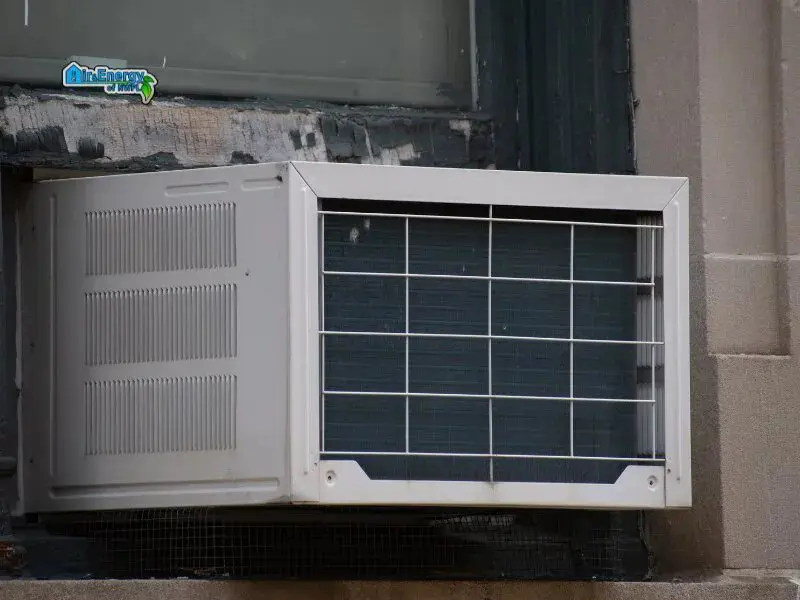Proper window air conditioner maintenance is crucial to ensure its efficiency and longevity. One common issue many homeowners face is water buildup, leading to leaks and reduced cooling performance.
This article focuses on guiding you through draining water from your AC window unit. Following these steps can prevent potential damage and maintain optimal performance. Read on to learn how to keep your window AC unit in top condition by effectively managing water drainage.
Causes of Window AC Water Buildup

Condensation Process
Water buildup in a window air conditioner primarily occurs due to condensation, which is part of the cooling process that removes moisture from the air. As the AC cools the air, it removes moisture, which condenses into water droplets. This water is usually drained outside but can accumulate within the unit if the drainage system is not functioning properly.
Blocked Drainage
Blocked drainage is another common cause of water buildup. Dirt, debris, and other particles can clog the drainage hole, and a clogged drain pan can also cause water buildup, preventing water from exiting the unit. Regular cleaning and maintenance are essential to ensure the drainage system remains clear and functional.
Improper Installation
Improper installation can also lead to water issues in window air conditioners. If the unit is not installed slightly downward toward the exterior, water can pool inside instead of draining out. Improper installation can also prevent the condenser fan from effectively spraying condensate through the condenser fins. Ensuring proper installation and periodic checks can prevent such problems.
Understanding these causes is vital for effective maintenance and preventing water damage in your window AC unit. By addressing condensation, clearing blockages, and ensuring correct installation, you can maintain your air conditioner's optimal performance and longevity.
Preparing to Drain Water
Turn Off and Unplug the Unit
Before starting any maintenance on your window AC unit, it is crucial to prioritize safety. Always turn off and unplug the unit from the power source. This step prevents electrical shocks and ensures your safety during the process.
Gather Necessary Tools
The right tools will make the job easier and more efficient. You will need:
- Bucket: To collect the drained water.
- Screwdriver: For accessing the drainage areas.
- Cloth: For cleaning and wiping away any excess water.
- Gloves: To protect your hands from dirt and debris.
- Drain pipe: To collect water from the window air conditioner and prevent issues like mold growth, rust stains, and becoming a breeding ground for insects.
Position the Unit Properly
To facilitate effective drainage, ensure your AC unit is positioned correctly. Ideally, the unit should tilt slightly downward towards the exterior. This tilt helps water flow out naturally, preventing it from accumulating inside. If your unit is not already tilted, you may need to adjust its position or use shims to achieve the proper angle.
Following these safety precautions and preparation steps, you can efficiently drain water from your AC window unit and maintain its optimal performance. Ensuring the unit is unplugged, gathering the necessary tools, and positioning the unit correctly is essential for a successful maintenance process.
Step-by-Step Guide to Drain Water
Locate the Drain Hole
First, you need to locate the drain hole on your window AC unit, which is crucial for removing excess moisture and preventing damage to the unit. The position of the drain hole can vary depending on the model and make of your unit.
Generally, the drain hole is located at the bottom of the unit, either at the rear or the side. Check your unit’s manual for specific information, or look for a small hole or rubber plug.
Clear the Drain Hole
Once you’ve found the drain hole, which is crucial for removing excess moisture and ensuring the efficient operation of the air conditioner, the next step is to clear any debris that might be blocking it.
Here’s how you can do it:
- Remove Obstructions: Use a screwdriver or a similar tool to carefully remove any visible obstructions.
- Clean the Hole: Use a small brush or a pipe cleaner to clear the hole thoroughly. If the hole is clogged with dirt or mold, you may need to use a mixture of water and vinegar to clean it out.
- Check the Pathway: Ensure the entire pathway from the drain hole to the exterior is clear by gently blowing air through it or using a soft wire to push any debris out.
Use a Drain Hose
If your window AC unit has an option to attach a drain hose, follow these steps:
- Attach the Hose: Connect one end of the hose to the drain hole. You can use a small cut-off section of a garden hose as a DIY solution. Ensure it fits securely to prevent leaks.
- Position the Hose: Place the other end of the hose into a bucket or direct it outside where the water can safely drain away.
- Secure the Hose: Use a small clamp to secure the hose, ensuring it won’t move or come loose while draining the water.
Using a cut-off garden hose can be a cost-effective and practical way to manage drainage from your window AC unit, ensuring efficient and safe water removal.
Drain the Water
Now you’re ready to drain the water from your window AC unit:
- Check the Position: Ensure the unit is still slightly tilted towards the exterior, allowing gravity to assist in draining the water.
- Open the Drain Plug: If a plug covers the drain hole, carefully remove it to start draining the water.
- Monitor the Flow: Allow the water to flow out naturally. If it slows down or stops, check for any new blockages in the drain hole or hose and clear them as necessary.
- Dispose of the Water: Once the water has drained completely, dispose of it appropriately, ensuring that no spillage occurs indoors.
Following these detailed steps, you can efficiently drain water from your AC window unit, ensuring optimal performance and preventing potential damage. Regular maintenance and proper drainage are key to the longevity of your air conditioner.
Maintaining Your Window AC Unit
Regular Cleaning
Regular cleaning is essential to prevent water buildup in your window AC unit. Dust and debris can clog the drain hole and filters, leading to inefficient operation. Clean the exterior and interior parts of the unit every few months using a damp cloth and mild detergent. Ensure all components are dry before reassembling.'
Check and Clean Filters
Filters should be checked and cleaned at least once a month. Remove the filters and wash them with warm, soapy water. Allow them to dry completely before reinserting. Clean filters ensure better airflow and prevent dust buildup.
Inspecting Drainage System
Regularly inspect the drainage system to ensure it is clear and functioning properly. Check the drain hole, drain pipe, and drip pan for blockages and clean them as needed. Periodically tilt the unit to ensure proper drainage and prevent water accumulation inside the unit. Maintaining your window AC unit can prevent water issues and extend its lifespan.
Troubleshooting Common Issues
Checking for Leaks
Leaks can cause persistent water buildup. Inspect the unit for cracks or gaps where water might escape, and use waterproof sealant to fix any identified leaks.
Ensuring Proper Installation
Improper installation can cause water issues. Ensure the unit is slightly tilted towards the outside to facilitate proper drainage. Use a level to check the tilt and adjust accordingly. Additionally, verify that the window seal is tight and secure to prevent water from seeping back into the room.
You can effectively manage and prevent water buildup in your window AC unit by addressing these issues.
Conclusion

Regular maintenance of your window AC unit is crucial to prevent water buildup and ensure optimal performance. By following the guide on draining water, cleaning filters, and inspecting the drainage system, you can avoid common issues and extend the life of your unit.
Those in or around Pensacola, FL, should consider seeking professional help. Proper AC maintenance improves efficiency and keeps your home comfortable and safe. For more tips and professional services, visit our website at Air and Energy of NWFL or contact us directly.

This article was written by:
Co-founder and Home Comfort Specialist

